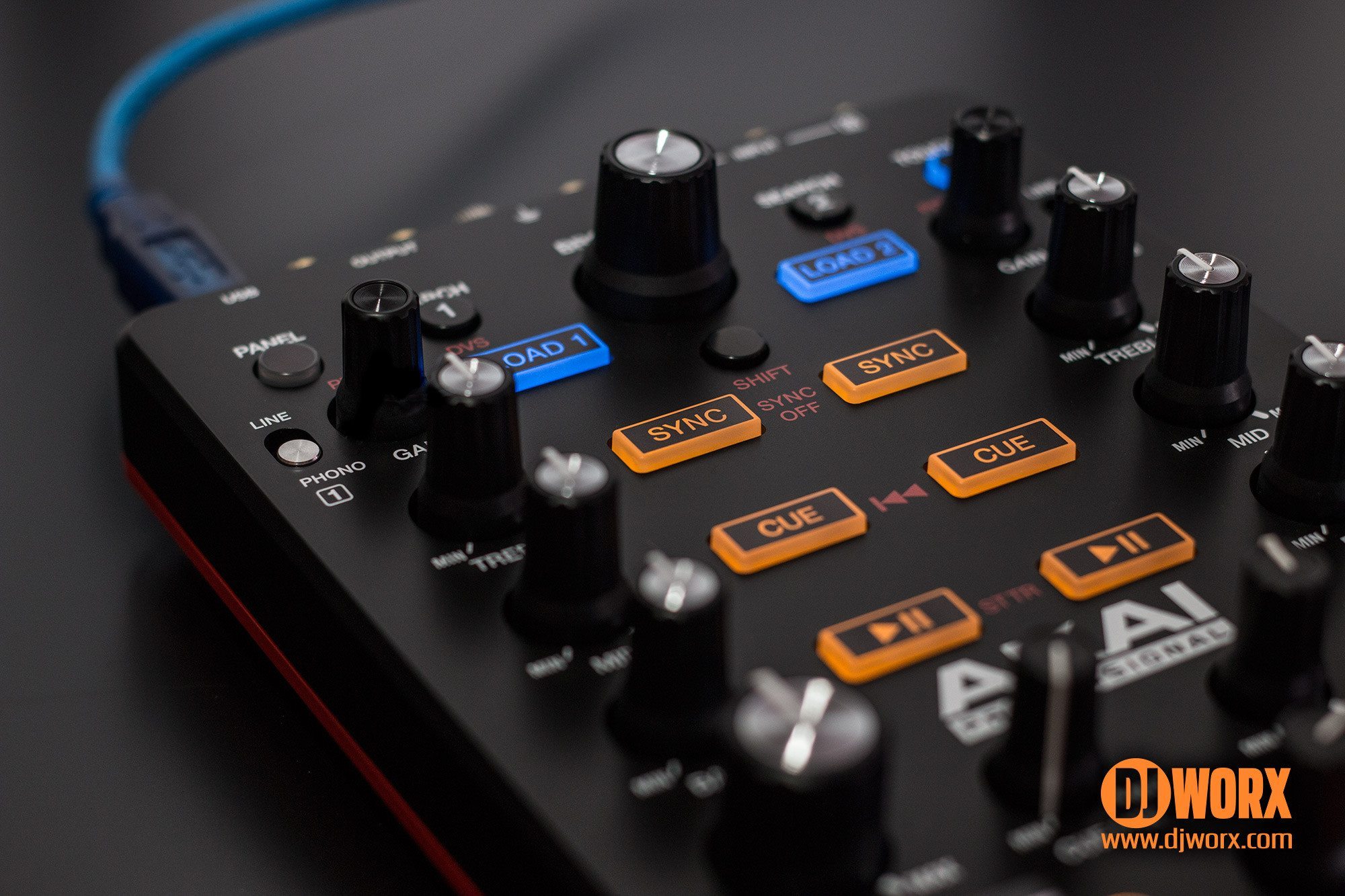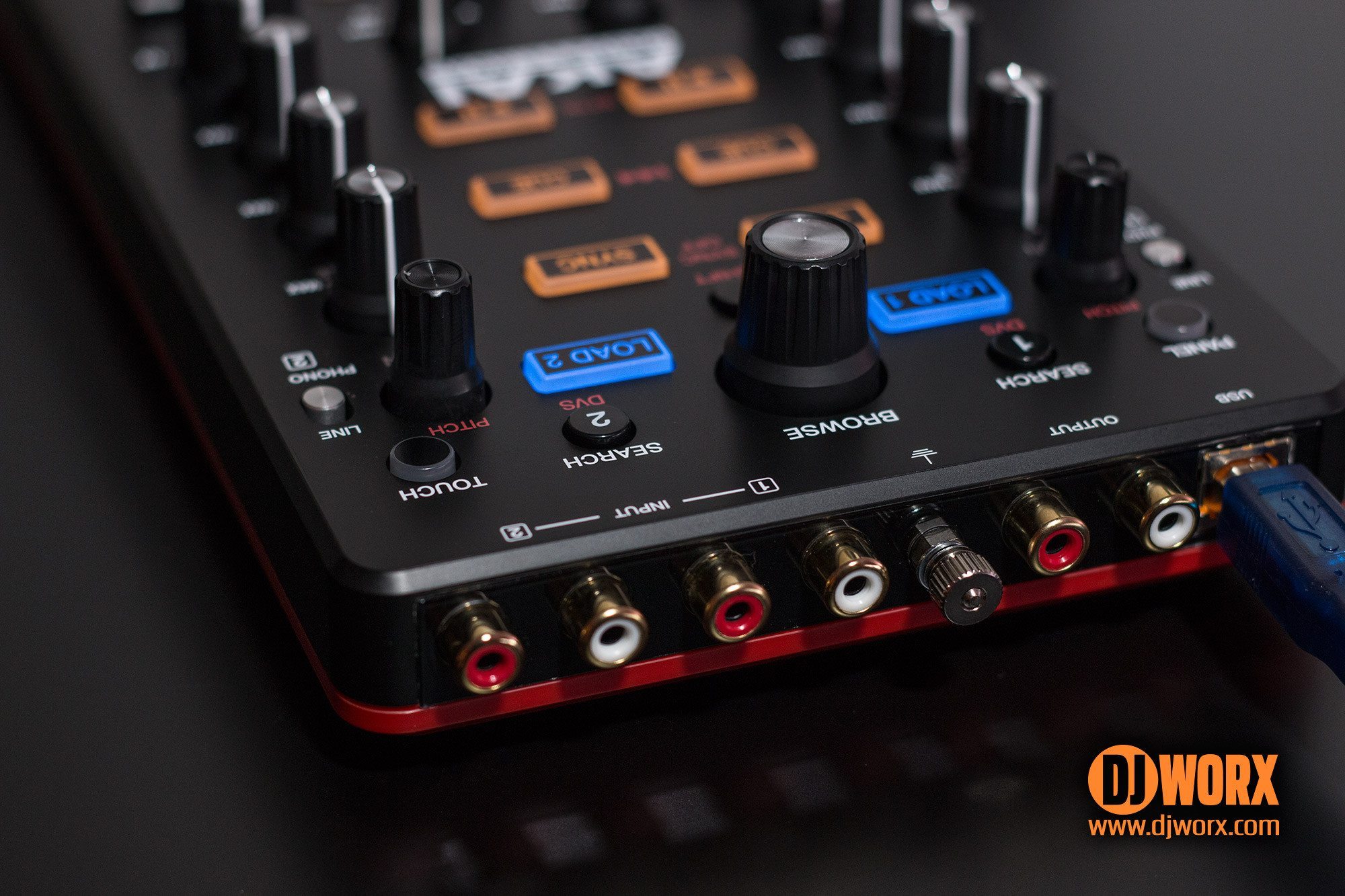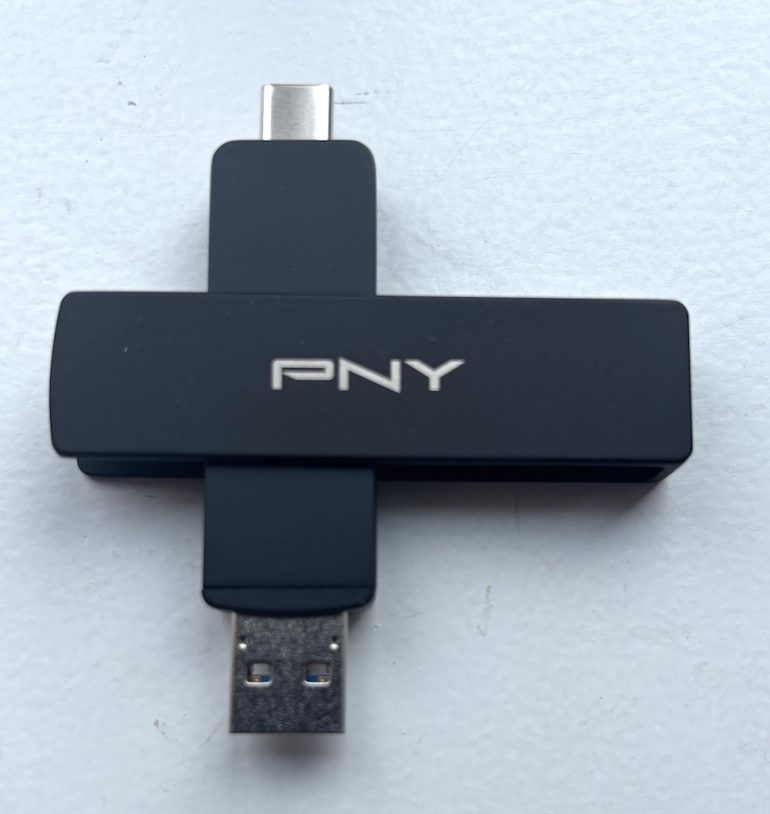Link: Akai | Price: $249/€238/£179 | User Guide: PDF
INTRODUCTION
The Akai Professional AMX is the first super-portable mixing controller for the Serato platform. Given its two-channel layout and the integrated audio interface, comparisons to its Traktor counterpart – the Native Instruments Z1 – seemingly can’t be avoided. However, that comparison is unfair to begin with, because the AMX isn’t just a controller for internal mixing. It can be upgraded on the software side to serve as a fully-fledged mixer with DVS functionality – as long as it’s connected to Serato DJ.
CONTROL LAYOUT
There really isn’t much to be said about the main mixer part of the AMX. It’s your standard 2-channel layout with gain controls, a 3-band EQ, 2-way filters and level indicator LEDs per channel. It does have a mini inno crossfader though, which makes it scratch-capable. Even on the tightest setting, I’ve found the cut-in to be a little larger than I’m used to – but this is a very individual thing, and it’s easy to get a little sloppy when you’re used to Rane standards. You’ll definitely have to try it yourself – at BPM, we’ve seen DJ Rasp rock it quite comfortably, so it may very well just be me. The crossfader is reversible by the flick of a switch, which is great for people like me who have a fader hand and a record hand as opposed to full-on ambidextrous tablists. The crossfader also can be bypassed in the settings if you prefer to mix with the line faders only. Turntablists may find that the line faders have a lot of resistance – flicking them up and down with one finger while working the crossfader is hard. At this point, it’s hard for me to tell if it’s just a matter of breaking them in, but they do have adjustable curves (just like the Numark NS7 mk2 and the NV) which is nice, although unlike the crossfader curve they’re only adjustable from within the settings menu.
As with the AFX, the capacitive knobs are where the fun’s at. A small “touch” button in the upper right hand corner turns the EQ knobs into instant kill switches, and touching the filter simultaneously activates loop rolls that get faster the further you move the knob from its center position. Those are also features we’ve already seen on the Numark NS7 mk2 and the NV, but it’s good to have them on something as portable as the AMX.
The unit also has basic transport controls – play, cue, stutter, rewind (as in “jump to the beginning of the track”) and sync. The big push encoder at the top of the device is used to navigate the library – but with either of the “search” buttons held down, it scrolls through the corresponding deck slowly, allowing you to pinpoint specific spots accurately. This is really good for setting hot cues when used together with an AFX, which has yet to receive an update improving the search strip resolution. When a track is playing, this function also doubles as pitch bend.
Speaking of pitch: in my AFX review, I mentioned that it doesn’t have pitch controls of its own (aside from pitch bend), but the AMX does. While playing with the unit, I noticed that using the AFX together with the AMX is actually the only way to effectively beatmatch manually when DJing with those units. If you use the AMX on its own, it’s going to be a royal pain because, putting it simply, the mapping makes no sense. It almost seems like they added pitch control in “pro forma”, just to be able to say “oh yeah, it’s in there”. Akai fans, put your pitchforks down and let me explain.
When you beatmatch using CDs or vinyl (or a controller for that matter), you pitchbend and move the pitch fader simultaneously. On the AMX, this is impossible unless you’re a mutant cyborg octopus – because both pitch and pitch bend are combo functions that each require a different button to be held down. So in order to adjust the pitch fader, you have to hold down the tiny shift button and turn the corresponding gain knob (by the way – I’ve seen better ideas than a double mapping on a gain knob, just saying), but you also have to hold down the search button and use the big push encoder to pitch bend. Of course, if you have an AFX, you can use its touch strip to pitch bend, but you still need to do acrobatics with the other hand that controls pitch on the AMX. Arguably, you could also “pitch ride” to beatmatch (pitch bend by moving the pitch up and down around the target value) – but pitch riding requires some kind of visual reference, and since the pitch control on the AMX is an endless rotary encoder, that’s just not going to work very well. The tiny graphical representation of a pitch fader in Serato DJ isn’t really helpful either. To be fair, the Native Instrument S8 has a rotary pitch control too – perhaps beatmatching really is a thing of the past? I certainly wouldn’t consider that the most important of all DJ skills – it matters what you play and when you play it.
In Akai’s defense, most people that would use the AMX will probably either DJ with something that has pitch controls on board or just hit SYNC anyway, but if your grids aren’t spot-on… well, you’re not going to have much fun here. This is particularly annoying because the shift button is not only very small, it’s also not backlit and located in a very impractical spot right between the SYNC and track load buttons. Good luck hitting that in a dark booth. And no – you can’t use either of the AFX‘s two big shift buttons, because these only affect the unit they’re part of. But you can’t blame Akai for that either – this is mostly due to the way Serato works internally.
Still, I really don’t understand why the shift button couldn’t have been the same as on the AFX. There would’ve been room, the positioning is unlucky anyway – might as well go for something that’s easier to hit and hold down. Let me photoshop that real quick using Akai’s own press shots for the sake of accurate proportions: left = original, right = my version.
Of course, changes like that are impossible after a product has been released, so here’s an idea: the gain knobs and the push encoder have no touch-related mapping – how about using the touch button to lock the gain knobs in pitch mode and the big encoder in pitch bend / search mode? Sounds both feasible and logical – and you won’t need an additional unit just to beatmatch comfortably.
CONNECTIONS
The AMX has two RCA stereo ins (phono and line) and one RCA stereo out. Nothing much to say here, you can’t really expect balanced XLR or 6.3mm outs on a unit this compact. Also, in most cases you’ll be sending the master out into a club mixer anyway. Seeing as the AMX’s internal audio interface boasts pretty impressive specs (24bit / 96kHz), honestly, I would worry more about a club’s old workhorse mixer degrading the sound quality than this unit. The headphone out is a 3.5mm jack – not a show stopper as this size is default for most headphones. Just detach the adapter and you’re good to go.
SERATO DVS EXPANSION
The AMX doesn’t come with Serato’s DVS pack – you have to buy it separately if you want to use the unit with a timecode source. This makes sense because the actual unit is cheaper for the end user, and not everyone wants to work with timecode – especially since together with the AFX, the AMX is a feature-rich portable solution for DJing. However, if you buy the DVS expansion pack, you’ll also be able to use any other audio interface capable of handling timecode inputs – so it’s generally not a bad idea to go for it.
With the DVS pack activated, you can use timecode vinyl as well as CDs. As mentioned before, the inputs can handle phono and line levels – and it all works flawlessly. With the shift button held down, the “search” button toggles between internal playback and whatever other mode was last selected in Serato DJ – this can be absolute or relative mode for timecode control, but also thru mode (their spelling, not mine) for when you, for example, want to play something off a regular record or CD. Sadly, you can’t choose that mode from the AMX or the AFX. At least the AFX lets you choose between absolute, relative and internal modes – but not thru. In real life terms, this means that DJs who spin with timecode will always have to reach for the laptop when they want to play a regular record or audio CD. I’m pretty sure this can be fixed with a mapping change as well.
POST-FADER EFFECTS? YES PLEASE!
The AMX supports post-fader effect return – that means that you will, for example, hear a delay or reverb tail even after you’ve faded out the effected track. This is pretty cool and works with external inputs as well – so you could even play something off a CD and still apply Serato effects to it. I honestly didn’t expect that – really cool.

SHOULD YOU GET ONE?
Like every piece of gear, the AMX is not perfect, but I’m sure both the unlucky approach to beatmatching and the way external audio sources are handled can both be fixed in a future update. Maybe there’s a way to implement Slip Mode as well? Neither the AMX nor the AFX have that option. Something I’d also like to see is a way to tweak filter resonance – just like on the Numark NS7 mk2 and the NV, the filter is pretty aggressive. A carrying case to lift the unit up to turntable height would also be a great addition – but as with the AFX, Akai tells me it’s definitely coming. Still, I can’t help but wonder if Electrix really is the only company that ever got this right with the Tweaker (which comes with both a sturdy carrying case and four incredibly stable screw-in legs at no extra cost). Oh well. In the meantime, Magma’s control cases (I’m using the one for the Push) or anything of similar size should do the trick.
If you’re looking for a portable Serato mixing interface, DVS or not – despite its minor shortcomings, I can definitely recommend the AMX.
LAST MINUTE UPDATE: A SNEAK PEEK AT THE CASES
We’ve just received three shots of the upcoming official carrying cases. No word on the price yet, but it’s probably safe to assume they’re not going to break the bank. It seems the cover has holes to fit the small rubber legs which will help keep the controllers in place – looks promising.
PRO
– DVS functionality is an option, keeping the initial purchase price low
– Post-fader effect routing
– Serato effects work on external inputs
– Capacitive knobs replicate mixer features known from Numark NS7 mk2 and NV
CON
– Tiny shift button placed in a less-than-ideal spot
– Downright impossible approach to manual beatmatching
– Turntablists will need to break in the line faders













Been considering these since I saw the original announcement – I think 2 AFX and an AMX will be a great replacement for my Mixtrack Pro (that I use for commercial gigs) and my PMC05 IV, which is a stunning mixer but feels long in the tooth now! How does the mini innofader stand up against the fader in the 05? has anyone tried both and can comment?
I’ve used a PMC05ProIV – I don’t have one here anymore to do a direct comparison, but I remember one clear difference. I can do crabs on the Vestax comfortably, but on the AMX, it wasn’t quite that easy because of the cut-in. I guess it would take some practice to do the switch – but as I said in the review, it’s always best to double-check everything yourself. Maybe it was just my unit.
P.S.: Remember you can always go for the good old credit card mod ;)
I usually have the cut in set pretty steep on my PMC, (well, steep compared to the absurdly small cut in it’s capable of) so this might not be such a bad thing. Guess I’ll wait for my local to get one in for demo and give it a whirl!
Mini innofader has a calibrate Button underneath.
Mine was too sharp a.k.a it didnt close until I re calibrated
Easy fix though
Did you calibrate the mini-inno? I did it to the one on my AMX and the cut it is right about where my friends 62 is, maybe a half mil difference.
To be 100% clear – these are not part of Worxmas. I tried to get them but inMusic can’t get enough of them. The review units I have must go back.
This is one of those “close but no cigar products” which in music is becoming notorious for. Well, when margins, not DJs make the design decisions, that’s what you get. 300 bucks and you still have to cobble together a way to get it to turntable height…#yougottabekiddinme you are not alone, so far I’ve been unimpressed by the mini innofader, too
I’m hoping they will bring out a bigger one with the 2 units combined and 2 usb ports/ soundcards. Along the same lines as a Rane 62. There isn’t currently a competitor to those mixers and would be good to see one soon.
I agree. I like the AMX and the AFX, but I’ll only add two AFX units to my Sixty-Four. But you have to keep in mind, a Rane mixer costs about as much as ten AMXs – so for people who work on a budget, this is definitely a good alternative.
I’ve bought both the AMX and the AFX two weeks ago, and honestly I’m very well impressed with these!! I’ve been entertained and exploring its capabilities since then! My Rane Sixty-Two hasn’t been touched yet :X, and I actually got to showcase these 2 units yesterday in a conference about electronic music here in Portugal.. Everyone was very interested and came to ask more questions! I’m telling you guys… These are breaktrough products. And no I’m not endorsed by Akai or any other brand. I’m simply a gear freak / turntablism enthusiast =)
Hey Mark do you think they will update the amx firmware so that the beatmatching turns every 0.1 not 0.4?
You have to talk to Serato about that – Akai can’t help you here, this is a software issue. The safest bet is generally to make sure your beat grids are set correctly. It’s a lot of work, but if you choose to rely on sync there’s no way around it.
Akai CAN help, because not only do we design these, we use them too!
We are currently fixing this bug with Serato, and the fix will be part of a release in 1st Quarter 2015.
Where do I know the firmware updates for this product? I am lost in the akai homepage.
There are no current firmware updates for the AMX, they work out of the box!
Any issues I have with it are mostly software related. I’d like to have a resonance control as well, and I’d like the gain to reset between tracks. When I load instant doubles, if I had the gain up for the previous track, I’ve gotta get it back down for the double. I’d be all over some different EQ crossovers as well, there’s too much mid in the low, and the high is too, well, high.
that said, I love the lil bastard… It’s completely reinvigorated my love for djing
Just a quick thing about the mini innofaders cut in point, it is re-calibratable on both sides if you follow the instructions on the innofader website. I have an AMX and you can achieve a much tighter cut in than the factory settings if you wish. This setting thereafter becomes your default and you can adjust the curve from the front panel as per usual, it’s a little fiddly but takes no more than 5 mins.
I get that there is a market for these, just not me. The idea of having to hook up two or three units with so many cables and the fact that they’re not at mixer height are deal breakers for me. Wouldn’t it’d be easier to just create one mixer with everything in it… sure it’d be a big mixer, but are we that desperate for table space and portability?
These look great for Serato users.
looks cool just tiny compared to my current setup…
Hi Guys,
Why can’t we just have the ability to use 2 AMX (with DVS support). I’m sure people would love the possibility to scale up with their budget. Personally I like to use 3 decks with DVS and my trusted MK2’s. I would much rather carry 2 of these to a gig that for instance having to assemble and do all the wiring with a “box”, etc…
Also with sync many people using (abusing?) 3 and 4 decks…
Maybe this is a way to not create any bad blood with Pioneer.
Cheers,
Z
PS – X-Acto performs excelent demos he should be Sponser by AKAI! ;)
Serato only supports one pro/audio enabled controller at a time, so only 1 AMX can be used at a time. Great idea though, I’d like to see the same thing.
I just got one of these and mapped it all to Traktor. Now thats what the z1 should have benn like. Its working like a charm, and I’m pretty sure I can hack it to make it work with Traktor time code. Just gotta wait till i’m back home with my mk2 to test it out.
This thing has tremendous potential to be pulled apart and rebuilt as a serato ready faderbox. I haven’t looked inside, but it sure seems like an easy mod to extend the cables on the crossfader, turn the whole thing on it’s side, install in a new enclosure, put that fader on top, and voila…serato faderbox. granted $350 with dvs extension is not cheap.
anybody that has one want to post a few pics of what you see when you take the crossfader out?
Does anyone one if the AMX can work with Serato Video? Meaning, are the faders MIDI?
*anyone know
Yes the AMX will control Serato Video!
Awesome
i am really thinking about getting one mainly because of the size/weight. i travel a lot by plane for my Dj gigs and most places i go it is not that easy to rent some DJ gear apart from cdj’s and pioneer mixers. not hating on pioneer stuff but it is just not the gear that works for me. an AMX is great as a portable mixer/serato box now i just need some lightweight, high torque turntables and i am good to go without passing the weight allowance.
So tempting. I was considering a controller like the Pioneer DDJ-SR, but using my DDJ-SP1 in combination with one of these would not only cost less, but would be far more portable. Suuuuper tempting.
Edit: Controlling pitch though… hmm.
I think the crossfader is too close to the edge..
I upgraded from Serato DJ Intro a while back for a controller i no longer use.
I was thinking of buying the Akai AMX to replace my SL1 as i already have the vinyls and was wondering if the Serato DJ licence covers the DVS plugin?
Anyone?
You need to buy the DVS expansion pack separately.
I thought so, thanks Mark.
I bought this controller on purpose just to use this “All-in-one” Traktor mapping: 4x decks, 6x hot cues, Loops, 5x insta-FX pages, “super cross fader”.
Also, my own upcoming extension adds Beatjump, Loop roll, Selectable FX control, Zoom + Layout changes, Library adv browsing.
https://maps.djtechtools.com/mappings/4397
Hi, guys!
Could you folks tell if one can record a mix (master out) on AMX without additional wiring? Is it that simple as just press the rec tab in Serato DJ software? If so this hardware is nothing but amazing.
As far as I’m aware, you just hit the record button in Serato DJ and that records it.
Sounds very promising! Thanks for answering, Mark!